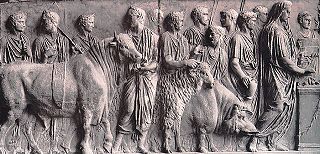
Lustratio
Encyclopedia

Ancient Rome
Ancient Rome was a thriving civilization that grew on the Italian Peninsula as early as the 8th century BC. Located along the Mediterranean Sea and centered on the city of Rome, it expanded to one of the largest empires in the ancient world....
and ancient Greek
Ancient Greece
Ancient Greece is a civilization belonging to a period of Greek history that lasted from the Archaic period of the 8th to 6th centuries BC to the end of antiquity. Immediately following this period was the beginning of the Early Middle Ages and the Byzantine era. Included in Ancient Greece is the...
purification ceremony, involving a procession
Procession
A procession is an organized body of people advancing in a formal or ceremonial manner.-Procession elements:...
and in some circumstances the sacrifice
Sacrifice
Sacrifice is the offering of food, objects or the lives of animals or people to God or the gods as an act of propitiation or worship.While sacrifice often implies ritual killing, the term offering can be used for bloodless sacrifices of cereal food or artifacts...
of a pig
Pig
A pig is any of the animals in the genus Sus, within the Suidae family of even-toed ungulates. Pigs include the domestic pig, its ancestor the wild boar, and several other wild relatives...
(sus), a ram (ovis) and a bull
Bull
Bull usually refers to an uncastrated adult male bovine.Bull may also refer to:-Entertainment:* Bull , an original show on the TNT Network* "Bull" , an episode of television series CSI: Crime Scene Investigation...
(taurus) (suovetaurilia
Suovetaurilia
The suovetaurilia or suovitaurilia was one of the most sacred and traditional rites of Roman religion: the sacrifice of a pig , a sheep and a bull to the deity Mars to bless and purify land ....
).
One reason for a Lustratio was to rid newborn children of any harmful spirits that may have been acquired at birth. The ceremony took place when the baby boy reached the age of nine days, or if a girl, eight days old, and the ceremony, the procession traced a magical boundary around the child to be purified. At the end of the ceremony, if the child was male, he was presented with a small charm, usually of gold, called a bulla and kept in a leather bag around the boy's neck. This bulla would be worn until the boy became a man and exchanged the child's purple-lined toga toga praetexta for the plain toga virilis of an adult. The Lustratio ceremony culminated with the naming of the child, the name being added to official Roman registers, and the observation of a flight of birds in order to discern the child’s future.
Lustratio ceremonies were also used to purify cities, objects or buildings, and on some occasions to purify an area where a crime had been committed. One notable occasion was a Lustratio held to purify Athens
Athens
Athens , is the capital and largest city of Greece. Athens dominates the Attica region and is one of the world's oldest cities, as its recorded history spans around 3,400 years. Classical Athens was a powerful city-state...
by Epimenides of Crete
Epimenides
Epimenides of Knossos was a semi-mythical 6th century BC Greek seer and philosopher-poet. While tending his father's sheep, he is said to have fallen asleep for fifty-seven years in a Cretan cave sacred to Zeus, after which he reportedly awoke with the gift of prophecy...
, after the Cylonian massacre. Lustratio ceremonies were also used to bless crops, farm animals, new colonies, and armies before going into battle or passing into review. In the latter case, troops were often ordered to the coastline, where half of the sacrifice would be thrown into the sea and the other half burnt on an altar. An example of this was the army of Macedon
Macedon
Macedonia or Macedon was an ancient kingdom, centered in the northeastern part of the Greek peninsula, bordered by Epirus to the west, Paeonia to the north, the region of Thrace to the east and Thessaly to the south....
that was lustrated by a dog being cut in half, and the army assembling between the location of the two halves, which were flung in opposite directions.
Instructions on the Lustratio performed for the Roman town of Iguvium illustrate that the ceremony consisted of a procession of priests and sacrificial victims around the town's citadel, stopping at the three gates to the citadel itself, where the sacrifices took place, as the gates were viewed as the weak points which required strengthening.

